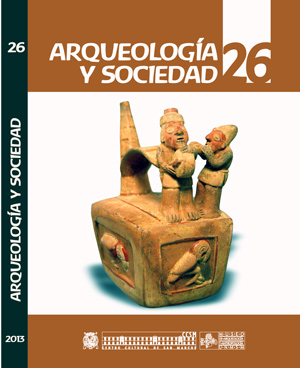INFRARED REFLECTOGRAPHY USE IN TATTOO REGISTRATION OF PARACAS-NECRÓPOLIS MOMIAS
DOI:
https://doi.org/10.15381/arqueolsoc.2013n26.e12391Keywords:
Tattoos, Paracas, Warikayan, infrared reflectorgraphy.Abstract
An exploration of the skin of twelve Paracas mummies using infrared reflectorgraphy has permitted the record of permanent cultural changes of the skin by tattoos. Infrared reflectography is typically used in the analysis of artwork, in particular to discover traces and designs hidden under paint layers. When used in mummies, the technique allows recording hidden tattoos. In many cases recording Paracas tattoos is difficult because the funerary treatment and bad preservation have camouflage tattoos, which are seem like blue or black stains in the skin. Results show characteristic of the Paracas skin modification that has never been registered before, such as pattern distribution of tattoos in the bodies and designs had been used for corporal decoration.Downloads
Published
Issue
Section
License
Copyright (c) 2013 Patricia Maita Agurto, Enma Minaya Cabello

This work is licensed under a Creative Commons Attribution-NonCommercial-ShareAlike 4.0 International License.
THE AUTHORS RETAIN THEIR RIGHTS:
a. The authors retain their trademark and patent rights, and also on any process or procedure described in the article.
b. The authors retain the right to share, copy, distribute, perform and publicly communicate the article published in the Arqueología y Sociedad (for example, place it in an institutional repository or publish it in a book), with an acknowledgment of its initial publication in the Arqueología y Sociedad.
c. The authors retain the right to make a subsequent publication of their work, to use the article or any part of it (for example: a compilation of their works, notes for conferences, thesis, or for a book), provided that they indicate the source. of publication (authors of the work, journal, volume, number and date).






